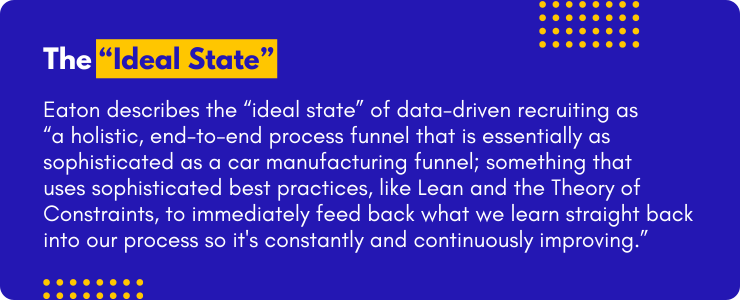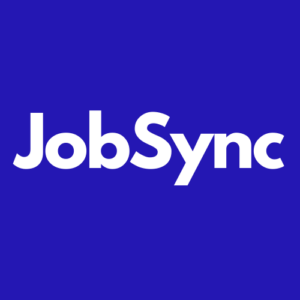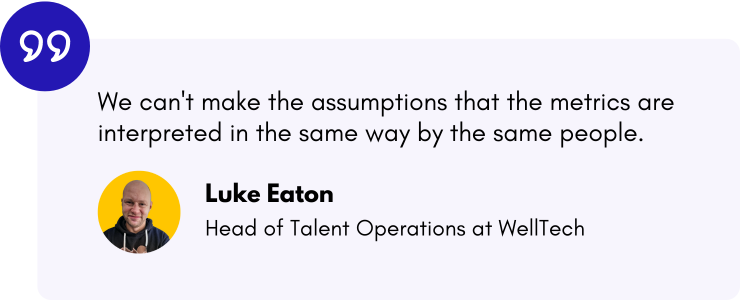
Talent acquisition leaders have access to more data than ever before to help guide their decision-making. Paradoxically, the abundance of data can be more distracting than anything… if you don’t know how to harness and use it. Taming the beast starts by implementing a coherent data strategy—here’s how you get there.
Recruiting is inherently an inefficient process. Most of the effort you put in and the money you spend results in the word ‘no’ — you don’t have to be a math person to know that is a waste.
When you’re operating from a position of inefficiency, finding ways to systematically and continuously optimize your processes becomes essential. For most talent acquisition (TA) functions, the answer lies in data. Data lets you see the true impact of your recruiting initiatives and translate it into focused business value. It’s the difference between shooting in the dark and having a clear target.
Currently, when TA uses data, it’s often limited to tracking TA-specific performance indicators such as time-to-fill, cost-per-hire, and source-of-hire. While these metrics are essential for monitoring the efficiency of the talent function, they’re only the opening chapter in the book of data-driven recruiting. Your organization has more data than you realize. You simply need to create a wish list of answers you want from the data and align that with your organization’s goals.
Said differently, data isn’t just about creating reports. Rather, it’s answering the crucial questions about your business and the health of your hiring process, then helping pinpoint where change will have the most impact. Reports tell you about the past; data guides your future.
While daunting, it’s an entirely doable task.
So, how do you, as a talent leader or hiring operations professional, get your data from where it is now to where it needs to be to support this goal?
Our recent roundtable inspires the following strategies with Luke Eaton, Recruiting Operations Expert at WellTech, and Ben Abear, Recruiting Operations Leader at Google Fiber. Eaton describes the “ideal state” of data-driven recruiting as “a holistic, end-to-end process funnel that is essentially as sophisticated as a car manufacturing funnel; something that uses sophisticated best practices, like Lean and the Theory of Constraints, to immediately feed back what we learn straight back into our process so it’s constantly and continuously improving.”
In other words, data is the enabler that improves your processes, and data itself is just another process to work through. Here’s how to position your data for success.
Eaton describes the “ideal state” of data-driven recruiting as “a holistic, end-to-end process funnel that is essentially as sophisticated as a car manufacturing funnel; something that uses sophisticated best practices, like Lean and the Theory of Constraints, to immediately feed back what we learn straight back into our process so it’s constantly and continuously improving.”

For more insight, check out our article Data: It’s Not a Dirty Word in Talent Acquisition, or you can watch the roundtable here.
#1. Understand your landscape (listen and learn)
Data is so complex that the chances of success from a numbers-first are lower than you might expect. Instead, start with a fact-finding mission with stakeholders, understanding their experiences and frustrations before examining available data that can pinpoint the root cause of the issues. Things like:
- How is the hiring process structured?
- How does work get handed off and progress?
- What is the usual time frame from start to finish?
- What are the conversion rates at each stage of the hiring funnel?
- Who owns each process, and to what outcome?
- Where are the bottlenecks?
“Talk to everyone who will talk to you,” Abear advises. “Build those relationships and understand from each user’s perspective: What does good look like? What of their experience has been good, bad, or indifferent? What would they change? What would they keep?” The goal is to prioritize the must-haves from the nice-to-haves by thrashing this out with teams on the ground.
#2. Rationalize the data
TA serves multiple constituencies—hiring managers, recruiters, HR, candidates, and leadership—each with its own priorities, expectations, metrics, reporting, data sets, and spreadsheets.
The next challenge is aggregating all that data and rationalizing it into a common model. Consider the areas below or work with a data professional to do this for you:
- What data are you working with?
- Where does the data come from, and how does it flow between users?
- How is data captured, stored, and shared today?
- How reliable is the data for decision-making?
- How do you access it or extract it from disparate systems?
- Which metrics are you not tracking that could drive business value?
While the number of stakeholders may be overwhelming, the good news is almost all of them need the same data to do their jobs. “Don’t worry too much about creating something brand new for all constituencies,” Eaton says. “Focus more on having rational, really accessible data and trying to break down those initial siloes, even if it means a conversation with finance, a conversation with the C suite, and a conversation with HR.”
#3. Identify root causes with data
Insights from your conversations with stakeholders are qualitative information. To get a more complete picture, use the data you’ve gathered to prove, disprove, or explain the thematic elements you discovered from talking with various teams. As Abear says, “You may not yet be in a position to ‘fix’ the issue directly, but you can begin to understand the biggest problems on a deeper level.”
Often, these issues are different from what many assume. “We’re not immune in TA from the finger-pointing game of ‘it’s this person’s problem or that person’s problem.’” Abear says. “It’s taking a look at the data and proving, here’s where [the problem] actually is, using data. Or sometimes there’s an absence of data, and we actually need to start collecting data. So start with the people and listen, just listen.”
#4. Frame the data for the user
Even when they have the same data, each stakeholder interprets and responds to it in vastly different ways. A recruiter may look at the number of quality candidates entering the funnel, while cost-per-hire will be more of a focus for someone whose profit and loss sheet is being impacted. High-level execs with investors on their backs might care about forecasts versus budget. Meanwhile, time-to-hire will be very important for someone who has lost a key player in their team.
Eaton says, “We can’t make the assumptions that the metrics are interpreted in the same way by the same people.”
Framing the data means reporting it in a way that tells the particular story each stakeholder is interested in. What data do they need to see or care about to make better decisions, and what format does it need to be in? What messages must you deliver to communicate the value of an activity, initiative, or investment?
“Rationalizing the data is about 80% of the work,” Abear says. “Once you have it to a high-quality level, getting it positioned and framed in a way relevant to your executive team, your HR, your recruiters, or everyone else in business finance is much easier.”
#5: Respond to the data
Once you understand where the inefficiencies lie, you can start making data-driven decisions for process improvement. If you have a low application rate, you could implement a more targeted recruitment marketing strategy or overhaul your application process. If people are quitting in their first six months, you might look closer at your selection and onboarding processes—what does your sentiment data tell you?
Eaton and Abear say this is a ‘propose and iterate’ process. You may not know where the data story will take you, but the data will give you the confidence to pick a point of view and test your hypothesis.
For Eaton, the challenge breaks down to a simple rule of thumb: “One, what’s the challenge? Two, what is the impact of the challenge? Three, what is our proposed solution, and four, what are the next steps?” Qualitative and quantitative data should inform and guide each of these steps in your decision-making process. As Eaton says, “If it’s not measured correctly, you may spend money on a solution that makes your problems worse.”
#6: Don’t let tools become your process
It can be overwhelming to take a hard look at your recruiting data and try to overhaul processes that have been in place for years. The temptation may be to rely on technology or tools to do the work for you. Again and again, we see organizations investing in tools that offer the big fix or the next big thing. However, layering a new tool on a poor process is like pouring new wine into old bottles; it may look like something has changed, but the underlying issues remain. It can seem easier to let the tools dictate the process, but in reality, the process must dictate the tools.
When you look at your ‘broken process,’ ask yourself, ‘Is it the process, or have we added technology to ‘help’ that has convoluted or broken our process?’ Starting with a clean slate, how would your hiring process run end-to-end? Then layer in the technology you cannot change, accounting for its limitations, and only then should you consider what needs to be changed or fixed.
This is one area where Abear thinks it’s time for a mindset shift: “Don’t let your systems or your tools become or be your process. I’ll keep saying that over and over. Think about what you want your process and your experience to be. Go on that journey first, and you will be especially delighted with all the outcomes you drive.”
#7: Use tools to bridge data gaps
With a clear process flow, now is the time to identify the data gaps. Data gaps can mean the absence of the data or the effort to capture or move the data is so high that it results in the failure to have the data consistently. When you think of data gaps, a few categories are important to consider:
- Why does the data gap exist? Is it due to the current tools’ failure to collect or transfer the data?
- What is compromised today due to the gap? Is the business abandoning some data in exchange for the most necessary data?
- Who does this data gap impact? Are you unable to respond to some candidates? Do recruiters take on manual data entry to bridge the gap? Does this slow your hiring process?
The most common data gaps occur because the entire tech stack doesn’t work together. Instead, the technology integrates a least common denominator model, forcing recruiting teams to accept less data or fill it in through heavy lifting and manual processes.
Unfortunately, the alternative is often just as bad—force all the data to be complete upfront. Putting that as part of your recruiting process inevitably means fewer candidates, poorer quality candidates, slower hires, and more work in other ways.
When you add new tools, ensure your process vets those tools to ensure they add to your holistic data approach. Too often, it’s easy to get excited about what a tool could do in a perfect environment rather than what it will do in your environment. Ensure new recruiting tools are additive holistically, making your data better, your process better, and your overall outcomes better. A few additional hires at the expense of your entire recruiting operations is never a win.



